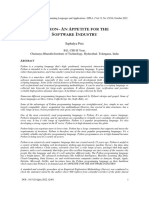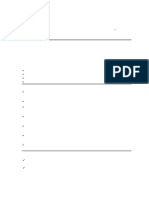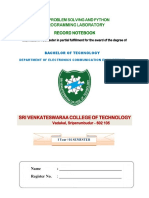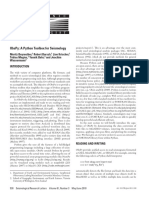0 ratings0% found this document useful (0 votes)
17 viewsIntroduction to Python
Uploaded by
supriya sundaramCopyright
© © All Rights Reserved
We take content rights seriously. If you suspect this is your content, claim it here.
Available Formats
Download as DOCX, PDF, TXT or read online on Scribd
0 ratings0% found this document useful (0 votes)
17 viewsIntroduction to Python
Uploaded by
supriya sundaramCopyright
© © All Rights Reserved
We take content rights seriously. If you suspect this is your content, claim it here.
Available Formats
Download as DOCX, PDF, TXT or read online on Scribd
You are on page 1/ 6
Introduction to Python
What is Python
Python is a general-purpose, dynamic, high-level, and interpreted
programming language. It supports Object Oriented programming
approach to develop applications. It is simple and easy to learn and
provides lots of high-level data structures.
Python is an easy-to-learn yet powerful and versatile scripting language,
which makes it attractive for Application Development.
With its interpreted nature, Python's syntax and dynamic typing make it
an ideal language for scripting and rapid application development.
Python supports multiple programming patterns, including object-
oriented, imperative, and functional or procedural programming styles.
Python is not intended to work in a particular area, such as web
programming. It is a multipurpose programming language because it can
be used with web, enterprise, 3D CAD, etc.
We don't need to use data types to declare variable because it is
dynamically typed, so we can write a=10 to assign an integer value in an
integer variable.
Python makes development and debugging fast because no compilation
step is included in Python development, and the edit-test-debug cycle is
very fast.
Python has many web-based assets, open-source projects, and a vibrant
community. Learning the language, working together on projects, and
contributing to the Python ecosystem are all made very easy for
developers.
Because of its straightforward language framework, Python is easier to
understand and write code in. This makes it a fantastic programming
language for novices. Additionally, it assists seasoned programmers in
writing clearer, error-free code.
Python is an open-source, cost-free programming language. It is utilized in
several sectors and disciplines as a result.
In Python, code readability and maintainability are important. As a result,
even if the code was developed by someone else, it is easy to understand
and adapt by some other developer.
Python has many third-party libraries that can be used to make its
functionality easier. These libraries cover many domains, for example,
web development, scientific computing, data analysis, and more.
Why learn Python?
Python provides many useful features to the programmer. These features
make it the most popular and widely used language. We have listed below
few-essential features of Python.
o Easy to use and Learn: Python has a simple and easy-to-understand
syntax, unlike traditional languages like C, C++, Java, etc., making it easy
for beginners to learn.
o Expressive Language: It allows programmers to express complex
concepts in just a few lines of code or reduces Developer's Time.
o Interpreted Language: Python does not require compilation, allowing
rapid development and testing. It uses Interpreter instead of Compiler.
o Object-Oriented Language: It supports object-oriented programming,
making writing reusable and modular code easy.
o Open Source Language: Python is open source and free to use,
distribute and modify.
o Extensible: Python can be extended with modules written in C, C++, or
other languages.
o Learn Standard Library: Python's standard library contains many
modules and functions that can be used for various tasks, such as string
manipulation, web programming, and more.
o GUI Programming Support: Python provides several GUI frameworks,
such as Tkinter and PyQt, allowing developers to create desktop
applications easily.
o Integrated: Python can easily integrate with other languages and
technologies, such as C/C++, Java, and . NET.
o Embeddable: Python code can be embedded into other applications as a
scripting language.
o Dynamic Memory Allocation: Python automatically manages memory
allocation, making it easier for developers to write complex programs
without worrying about memory management.
o Wide Range of Libraries and Frameworks: Python has a vast
collection of libraries and frameworks, such as NumPy, Pandas, Django,
and Flask, that can be used to solve a wide range of problems.
o Versatility: Python is a universal language in various domains such as
web development, machine learning, data analysis, scientific computing,
and more.
o Large Community: Python has a vast and active community of
developers contributing to its development and offering support. This
makes it easy for beginners to get help and learn from experienced
developers.
o Career Opportunities: Python is a highly popular language in the job
market. Learning Python can open up several career opportunities in data
science, artificial intelligence, web development, and more.
o High Demand: With the growing demand for automation and digital
transformation, the need for Python developers is rising. Many industries
seek skilled Python developers to help build their digital infrastructure.
o Increased Productivity: Python has a simple syntax and powerful
libraries that can help developers write code faster and more efficiently.
This can increase productivity and save time for developers and
organizations.
o Big Data and Machine Learning: Python has become the go-to
language for big data and machine learning. Python has become popular
among data scientists and machine learning engineers with libraries like
NumPy, Pandas, Scikit-learn, TensorFlow, and more.
Where is Python used?
Python is a general-purpose, popular programming language, and it is
used in almost every technical field. The various areas of Python use are
given below.
o Data Science: Data Science is a vast field, and Python is an
important language for this field because of its simplicity, ease of
use, and availability of powerful data analysis and visualization
libraries like NumPy, Pandas, and Matplotlib.
o Desktop Applications: PyQt and Tkinter are useful libraries that
can be used in GUI - Graphical User Interface-based Desktop
Applications. There are better languages for this field, but it can be
used with other languages for making Applications.
o Console-based Applications: Python is also commonly used to
create command-line or console-based applications because of its
ease of use and support for advanced features such as input/output
redirection and piping.
o Mobile Applications: While Python is not commonly used for
creating mobile applications, it can still be combined with
frameworks like Kivy or BeeWare to create cross-platform mobile
applications.
o Software Development: Python is considered one of the best
software-making languages. Python is easily compatible with both
from Small Scale to Large Scale software.
o Artificial Intelligence: AI is an emerging Technology, and Python
is a perfect language for artificial intelligence and machine learning
because of the availability of powerful libraries such as TensorFlow,
Keras, and PyTorch.
o Web Applications: Python is commonly used in web development
on the backend with frameworks like Django and Flask and on the
front end with tools like JavaScript and HTML.
o Enterprise Applications: Python can be used to develop large-
scale enterprise applications with features such as distributed
computing, networking, and parallel processing.
o 3D CAD Applications: Python can be used for 3D computer-aided
design (CAD) applications through libraries such as Blender.
o Machine Learning: Python is widely used for machine learning due
to its simplicity, ease of use, and availability of powerful machine
learning libraries.
o Computer Vision or Image Processing Applications: Python
can be used for computer vision and image processing applications
through powerful libraries such as OpenCV and Scikit-image.
o Speech Recognition: Python can be used for speech recognition
applications through libraries such as SpeechRecognition and
PyAudio.
o Scientific computing: Libraries like NumPy, SciPy, and Pandas
provide advanced numerical computing capabilities for tasks like
data analysis, machine learning, and more.
o Education: Python's easy-to-learn syntax and availability of many
resources make it an ideal language for teaching programming to
beginners.
o Testing: Python is used for writing automated tests, providing
frameworks like unit tests and pytest that help write test cases and
generate reports.
o Gaming: Python has libraries like Pygame, which provide a platform
for developing games using Python.
o IoT: Python is used in IoT for developing scripts and applications for
devices like Raspberry Pi, Arduino, and others.
o Networking: Python is used in networking for developing scripts
and applications for network automation, monitoring, and
management.
o DevOps: Python is widely used in DevOps for automation and
scripting of infrastructure management, configuration management,
and deployment processes.
o Finance: Python has libraries like Pandas, Scikit-learn, and
Statsmodels for financial modeling and analysis.
o Audio and Music: Python has libraries like Pyaudio, which is used
for audio processing, synthesis, and analysis, and Music21, which is
used for music analysis and generation.
o Writing scripts: Python is used for writing utility scripts to
automate tasks like file operations, web scraping, and data
processing.
Python Popular Frameworks and Libraries
Python has wide range of libraries and frameworks widely used in various
fields such as machine learning, artificial intelligence, web applications,
etc. We define some popular frameworks and libraries of Python as
follows.
o Web development (Server-side) - Django Flask, Pyramid,
CherryPy
o GUIs based applications - Tk, PyGTK, PyQt, PyJs, etc.
o Machine Learning - TensorFlow, PyTorch, Scikit-learn, Matplotlib,
Scipy, etc.
o Mathematics - Numpy, Pandas, etc.
o BeautifulSoup: a library for web scraping and parsing HTML and
XML
o Requests: a library for making HTTP requests
o SQLAlchemy: a library for working with SQL databases
o Kivy: a framework for building multi-touch applications
o Pygame: a library for game development
o Pytest: a testing framework for Python
o Django REST framework: a toolkit for building RESTful APIs
o FastAPI: a modern, fast web framework for building APIs
o Streamlit: a library for building interactive web apps for machine
learning and data science
o NLTK: a library for natural language processing
You might also like
- Python Machine Learning For Beginners Ebook Final100% (10)Python Machine Learning For Beginners Ebook Final305 pages
- Essential Guide To Python For All Levels (2024 CollectionNo ratings yetEssential Guide To Python For All Levels (2024 Collection184 pages
- The forest was alive with the sound of rustling leaves and the occasional snap of a twig underfootNo ratings yetThe forest was alive with the sound of rustling leaves and the occasional snap of a twig underfoot3 pages
- Python - An Appetite For The Software IndustryNo ratings yetPython - An Appetite For The Software Industry14 pages
- Python - An Appetite For The Software IndustryNo ratings yetPython - An Appetite For The Software Industry14 pages
- Python Programming Unit - I: History of PythonNo ratings yetPython Programming Unit - I: History of Python18 pages
- Que 1. What Is Python?: 1) Easy To Learn and UseNo ratings yetQue 1. What Is Python?: 1) Easy To Learn and Use11 pages
- Learning Python by Example ACE INTL NodrmNo ratings yetLearning Python by Example ACE INTL Nodrm331 pages
- Practical Guide to Python: From Basics to Advanced ProgrammingFrom EverandPractical Guide to Python: From Basics to Advanced ProgrammingNo ratings yet
- Cs Sem III Dav Upc 2343012002 Sl. No. Qp. 1673 Dec '23No ratings yetCs Sem III Dav Upc 2343012002 Sl. No. Qp. 1673 Dec '2312 pages
- Python for Scientists 2nd Edition John M. Stewart pdf download100% (2)Python for Scientists 2nd Edition John M. Stewart pdf download84 pages
- Image Processing With Opencv Python: Kripasindhu SarkarNo ratings yetImage Processing With Opencv Python: Kripasindhu Sarkar67 pages
- ALGORITHMIC_THINKING_WITH_PYTHON_LAB_MANUAL[1] (1)No ratings yetALGORITHMIC_THINKING_WITH_PYTHON_LAB_MANUAL[1] (1)43 pages
- Matplotlib Tutorial Learn Matplotlib by Examples B08XYJB9K3100% (5)Matplotlib Tutorial Learn Matplotlib by Examples B08XYJB9K3204 pages

































































































